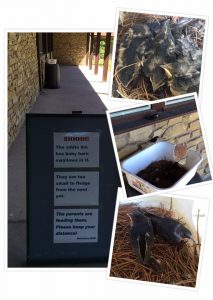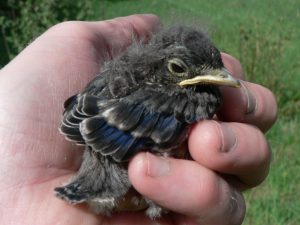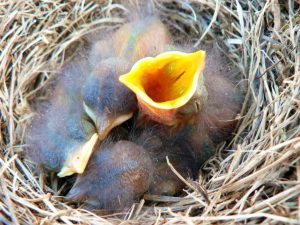This time of year, many people will find baby birds that have fallen out of the nest and want to help. Stop! First, we need to know the facts about baby birds and the best possible ways we can help them. Baby birds are cute and fluffy and our instincts tell us that when we find it on the ground we need to care for it ourselves, but the baby’s best chance at survival is actually to stay in nature. Taking a chick from where you found it and moving it could make things worse!
There are different circumstances to consider depending on where you found the baby, what condition the baby is in, and how old the baby seems to be. If the baby is near the nest and doesn’t have many feathers, then it is best to put the baby back in its nest. It is just fine to touch them! Birds do not abandon their chicks if they happen to smell differently; that is a myth. If the nest is out of reach, be sure to put the baby out of harm’s way and within sight of the nest, and mom will do the rest! We were successful at the Sanctuary when a barn swallow nest fell and we were able to use some items on hand to contain the nest off the ground for mom and dad to care for the babies.

When a Barn Swallow nest fell down, our Animal Care Staff placed it into a bin and the parents came back to feed the chicks!
If the baby has many feathers and looks similar to an adult bird, but isn’t acting like an adult, then leave the baby be. This is a fledgling. Fledglings leave the nest and can fly a little, yet they still rely on their parents to feed them and care for them. Their coloration is not quite like the adult birds yet, and sometimes they still have downy feathers that are visible. You can monitor the baby bird, in either of these situations, from a distance to see if the parents are actively caring for them.
If you find a baby bird that is visibly injured or you have proof that the nest has been abandoned, then call your local wildlife rehabilitator. To find your local rehabilitator you can go to http://www.michigandnr.com/dlr/. The Sanctuary cannot take in animals that need rehabilitation.
Birds are wildlife and taking a native bird from the wild is illegal without specific permitting from the state or federal government. Nature may seem harsh at times, yet only the strongest specimens survive. Birds will lay many eggs, so that there are more babies that may survive. Only 20% of birds will make it through their first year, and that’s all part of the circle of life. You can help by planting bird and insect friendly native plants in your own backyard! This will give the birds more options of food for feeding their young. Also, keep your pet cat indoors. The American Bird Conservancy reports that “in the United States alone, outdoor cats kill approximately 2.4 billion birds every year.”
Again, stop and think before moving a baby bird, this could be more harmful then helpful!
Shae Borenstein
Animal Care Technician



A legacy of conservation; a commitment to sustainability.
Kellogg Bird Sanctuary12685 East C Avenue
Augusta, MI 49012
Phone: (269) 671-2510 birdsanctuary@kbs.msu.edu